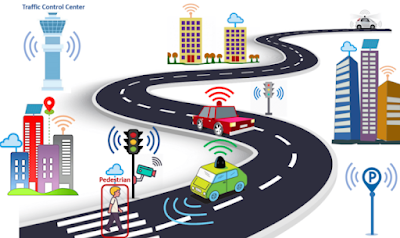This is the promise of the smart city - urban living reimagined through technology. Intelligent infrastructure and real-time data promise safer, greener, more livable cities for all. However, these innovations did not come overnight. Weaving EVs into the smart city landscape remains an evolving challenge. How exactly do smarter roads enable the electric future?
Traffic monitoring in smart cities
Smart cities' beating hearts are advanced traffic management systems. Armed with real-time data from embedded road sensors and smart commercial security camera systems, these solutions adaptively adjust intersections to optimize traffic flow. Skipping red lights becomes a relic of the past. With vehicle-to-infrastructure connectivity, the system coordinates cars to prevent congestion, reduce accidents, and maximize efficiency.
These smooth-flowing roads are vital for EVs. Studies show that stop-and-go traffic reduces EV efficiency and range. By easing congestion, smart traffic management extends the reach of EVs while reducing charging needs. Adaptive signals also give EVs longer greens when approaching intersections. This helps them conserve momentum and energy.
The interplay between smart cities and electric vehicles
The genius of smart cities is their synergistic nature. Investments in sensors, broadband, and urban efficiency pay dividends across multiple areas. This interplay is evident with EVs.
- Smart grid technology enables cities to integrate EV charging with renewable energy. Vehicle-to-grid integration further optimizes charging schedules and grid loads. Intelligent charging stations can identify individual EVs and bill them accordingly.
- In return, growing EV adoption supports smart city goals. Their zero-emissions nature helps cities combat pollution and climate change. EVs reflect the high-tech ethos smart cities aim to project to attract talent and investment.
This synergistic relationship creates positive feedback loops where smart cities bolster EV adoption while EVs amplify smart cities' sustainability benefits.
Challenges in integrating EVs and smart cities
However, pockets of friction remain in weaving EVs into smart city ecosystems. Infrastructure demands pose challenges, as cities must invest in thousands of public charging stations along highways and streets. Effective station placement requires analysis of commuting patterns and land use.
Smart power grid management also grows more complex with the vehicle-to-grid integration of millions of EVs. Utilities must prevent overload from uncontrolled mass charging. Rate structures and incentives must be implemented to encourage off-peak charging.
Policies around public charging, building codes, and preferential parking for EVs need development. Laws that treat EVs differently from gas vehicles regarding registration and gas taxes may require overhaul. Smooth integration relies on policies keeping pace with technology.
Future trends shaping smart cities and EV adoption
Looking ahead, emerging innovations promise deepened symbiosis between EVs and smart cities. Smarter artificial intelligence will optimize energy and transport systems, aided by proliferating sensors across built environments.
- Vehicle-to-everything (V2X) connectivity will expand, allowing cities to coordinate EVs, public transit, and pedestrian infrastructure into a seamless mobility ecosystem. According to research, V2X technologies could reduce traffic congestion in urban areas.
- Autonomous ridesharing fleets will also reshape urban landscapes. By 2030, autonomous vehicles could account for 25% of miles traveled in the U.S., reducing the number of vehicles on city streets by 60 million, per Boston Consulting Group.
- Rooftop solar arrays, expanded microgrids, and breakthroughs in energy storage will empower cities to harmonize local renewable generation with EV charging loads. The global microgrid market is projected to be nearly quintuple between 2019 and 2028, from 8.1 billion to 40 billion, according to Navigant Research.
- As storage costs fall, the global grid-connected stationary battery storage market is predicted to grow 15-fold by 2030, as per BloombergNEF.
With smarter energy management systems, cities could integrate over 30% solar and wind capacity by 2030 while maintaining grid reliability, finds the National Renewable Energy Laboratory.
Final thoughts
Smart cities herald a world where technology brings convenience, health, and sustainability to everyone. By leveraging traffic data and adaptive controls, smarter roads allow EVs to deliver on this vision. Yet work remains in infrastructure, grid management, and policy to enable seamless integration. As smart cities grow ever more imaginative in tapping technology for the public good, the streets of tomorrow get brighter.











